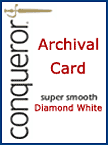Workshop Plus
WORKSHOPS 2025
- Latest posts:
- Susan Wk3
- Ida Wk6
- Debra Wk2
- Carolyn Wk7
Susan (Assisted Online Intermediate)
WEEK 3 EXERCISE 1

I'm not including erasing because that leaves soft edges and rarely returns paper to its pristine white surface.
WEEK 3 EXERCISE 2
We have a pair of table lamps that are mainly 'open' on the base. I thought one of those would make a good subject for negative drawing.

Please forgive some of the maladjusted lines...I have hand tremors that get out of control sometimes :(
Thanks for letting me know. My Brother-in-Law has a similar problem. In the next exercise you'll be leaving organic white shapes in the background, so you need to be able to see the white shapes in order to shade around them, but you might also need to rest if you feel the tremors arising. Possibly you don't find it to be a problem if you're drawing along an edge? But sometimes you'll be shading up to and stopping at an edge so you might want to rest before tackling that. But you'll know better than me about that.
In the final exercise you'll be creating hair. And that is where you'll find working negatively ESSENTIAL! Remember, when drawing hair, you draw the background between the hairs and not the hairs themselves. That's because when you look at hair you see the edge of each hair because of the darker gaps between the hairs. Many people try drawing pencil lines to represent hair but that's the wrong way round. They create dark hairs on a light background. Reality is the opposite.
I really goofed... As you can tell, I made the tragic mistake of putting down a few lines of the desk before beginning shading the negative space. You cautioned us about that; I am a bad student! :)
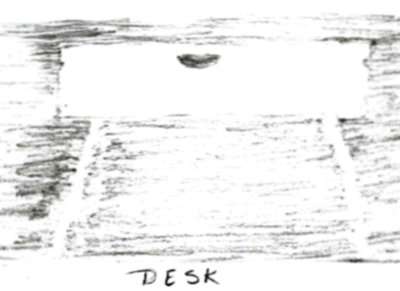
I'm pleased with the door, but I goofed on the table, too. From the angle where I was sitting, I could see the back leg (left side), but I neglected to include the negative space around it to indicate that angle. Again...bad, bad Susan! :)

These exercises were intended to get your brain used to seeing negatively before you moved on to the next exercise by helping you to "see" white shapes as you shade around them. The only white we have is the white of the paper and often, as we draw, accidental white shapes and gaps will appear. You need to be aware of those white shapes and to recognise them for what they suggest or can be made into. And it gives you the ability to create white shapes as you draw simply by imagining they are there - bits of straw on a barn's floor for example, that you can later return to and add detail.
WEEK 3 EXERCISE 3

It would appear that you created the mottled background throughout. If you did then it's overdone. This is a dark forest; I'd expect some light to be filtering down from the top, so it would become darker with depth. And the effect is supposed to suggest background foliage, which is unlikely to reach ground level.
Let's get the big error out of the way...
Then, I decided the tree in the foreground needed some shading...after all, no tree - not even a birch tree - is completely white. That is where, I believe, I ran into challenges of keeping differentiation between the "grounds."
I think you were a little too timid at the outset, and too generous with the organic shapes. The black background is OK (although the organic shape mottling does make it look lighter than it is). It's difficult to be bold until you gave enough experience under your belt, so don't let that concern you. Learning to be bold where it matters is a problem that will solve itself in time.
Personally, I would have pushed the background tree much deeper into the gloom. And the midground tree, too. Then the foreground tree would have leapt forwards and visually pushed the other two even further back, creating lots of depth.
This exercise is really about creating depth (not just about trees!). First, your darks need to be dark and solid. The lighter patches can represent foliage just glimpsed in the background gloom, but include too many and you make the darks look a lot lighter. The darks in this represent the extreme background shade, where no light is filtering into the dark wood.
Then, if your background tree almost merges into the gloom it will give you a lot of options for the midground and foreground trees. If, for example, your midground tree is as light as the foreground one, there won't appear to be any recession at all.
So, if you strengthen the background darks by filling in some of the organic shapes (the mottling) - maybe completely lower down - you'll make them more solid, And then I think you'll be surprised how dark you can make the background and midground tree without them disappearing. Pushing them back into the shade will add mystery. Quickly done, but something like this:
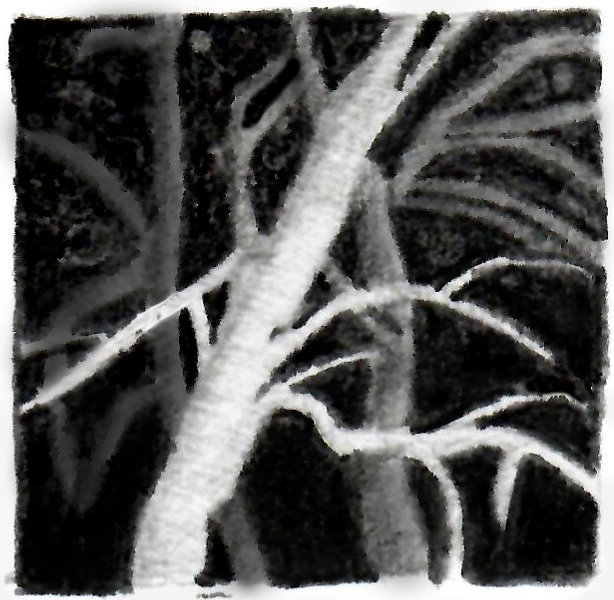
Ida (Online Advanced)
WEEK 6: EXERCISE 1: TWIGS
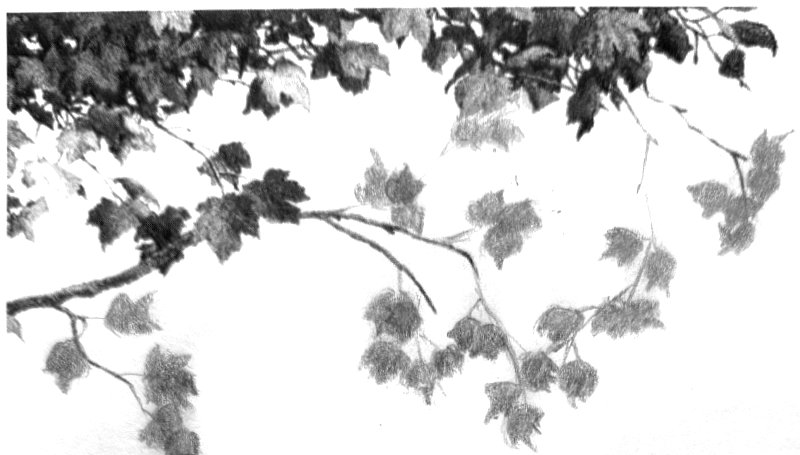
You would have learned more if you had continued to use the much greater range of contrast in the existing drawing. You could, for example, have used unrecognisable shapes behind a single recognisable Sycamore leaf. The eye will see that and assume every thing else is also leaf. And we'd be happy to read the partial leaf-like shapes further back as depth. One thing I learned a long time ago is that little is immediately understandable in Nature - other than the immediate foreground - so adding "mysterious" shapes behind will increase the overall sense of reality.
Now for the good stuff :) Your additions steer my eye around very well. Assuming this area is at the top left of a drawing (which, in fact, it was), then the need is to point the eye right from the left-hand side, and down. In that, you've succeeded very well.
WEEK 6: EXERCISE 1: POST
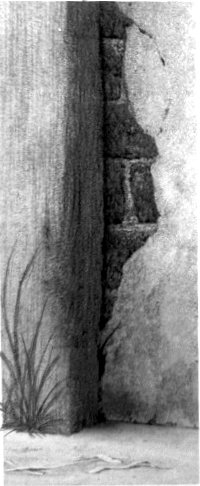
WEEK 6: EXERCISE 1: POST

First, you were asked to let a bug chew holes through the leaves, but your holes are in the furthest leaf. Placed on the central leaf, they could have exposed leaf beneath and added depth. On the plus side, the hole you created does have a thickness described by the narrow highlight. Excellent! Try whenever you can to think about the natural way everything would look if you had it in front of you - and then how you can best turn it to your advantage.
You could also have used a lot more contrast. I'd use that to create the cast shadows, because they both suggest depth and separation. And, in this case. I'd want to use strong light with sharp-edged shadows, and that needs good contrast. I've had a (not very successful) go at it...
WEEK 6: EXERCISE 2: BOAT

WEEK 6: EXERCISE 2: FIREPLACE
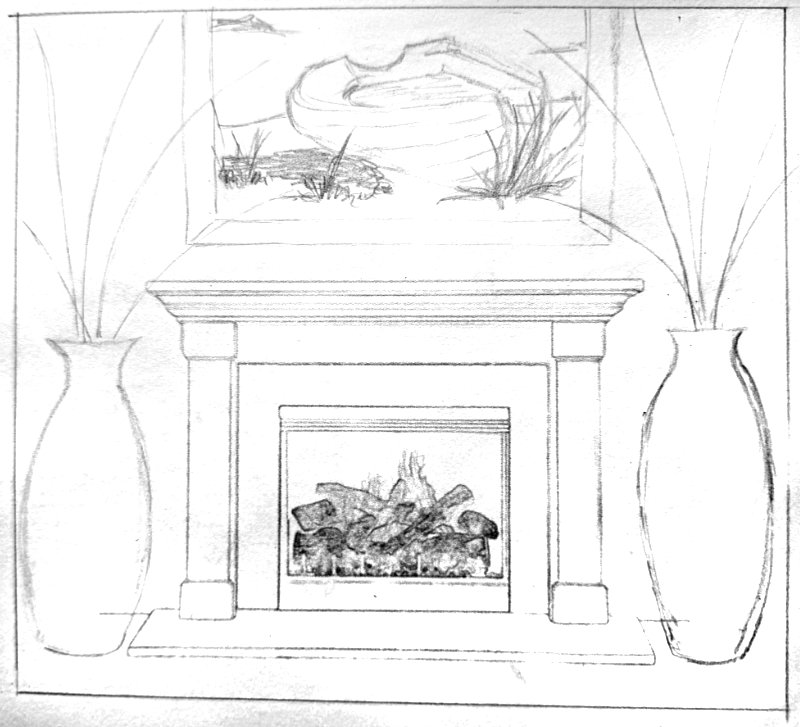
This does what you set out to. It sends my eye around in a circular motion - in either direction - and keeps it within the frame.
Debra (Assisted Online Intermediate)
WEEK 2: EXERCISE 1
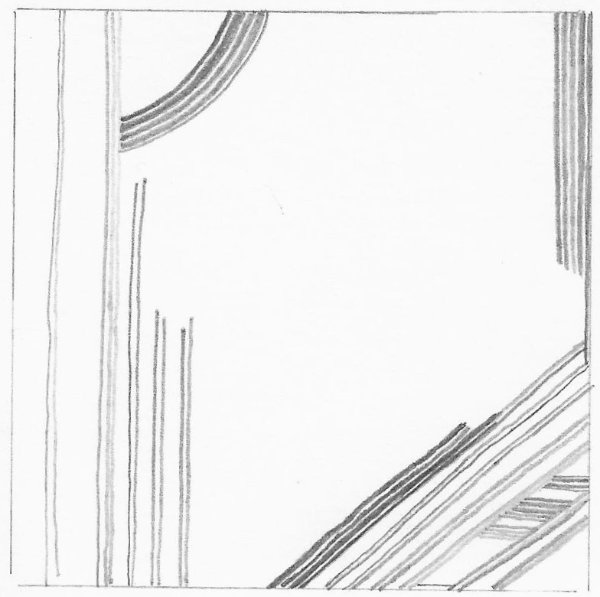
WEEK 2: EXERCISE 2
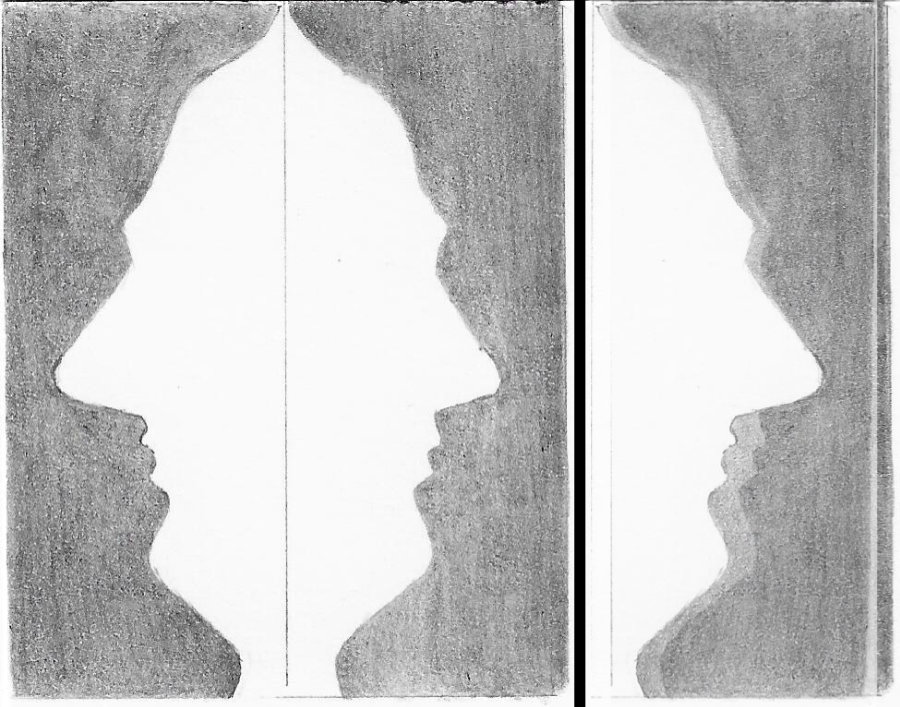
I did not do the cutting and switching as I am aware of this exercise and I wanted to get on to the next exercise.
Fair enough!
This is a very accurate result. As with Susan's, I flipped the left-hand half over onto the right-hand half... and apart from the longer nose, they're remarkably similar. Well done!
WEEK 2: EXERCISE 3
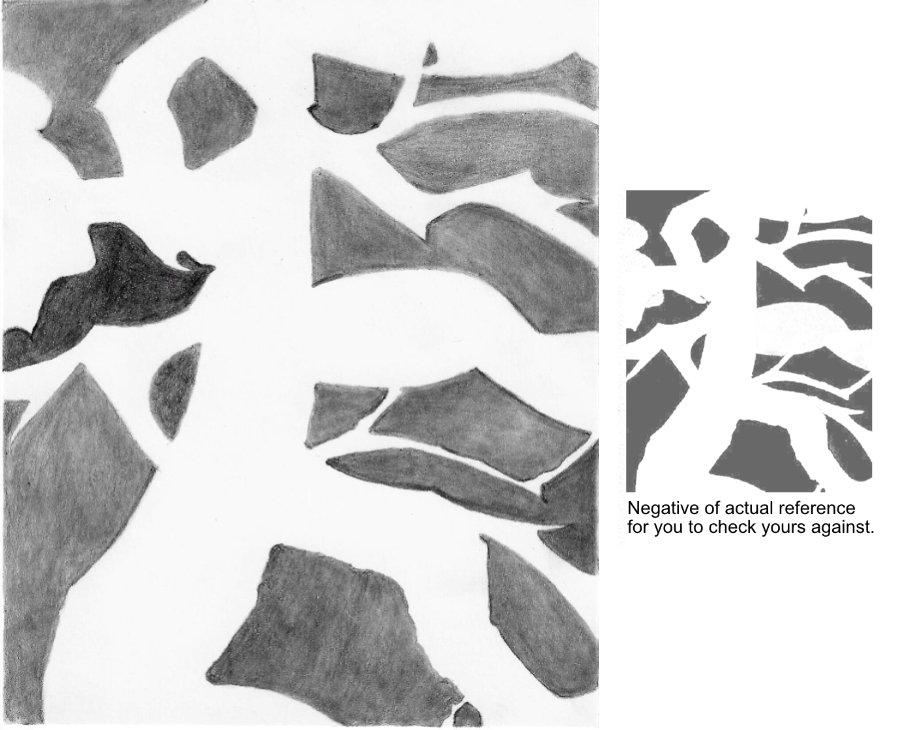
This was hard! I found I often saw what needed to be a bump or projection in the negative space and did not interpret it correctly. I can see why you emphasize practice. Overall, I " get" the concept but the devil is in the details.
Good work, Debra, this is virtually flawless. Keep practising. Once you become used to seeing negative space, you'll find it's an incredibly powerful tool with a myriad of uses - especially when you have problems correctly seeing a positive shape. Switching to drawing the negative spaces around it almost always solves the problem. And the good news... it becomes progressively easier with practice.
I also learned a lesson.. I got so involved in trying to get a shape correct that I forgot to move the card that protects the work from my hand. When I finished, I discovered I had smeared half of the picture. Not funny! Glad I learned that on a lesson and not on an actual piece. I tried to correct the smear as best I could but as you have mentioned in the past, it will never be the pristine white.
I'm really pleased that happened and that it happened when it did. It is unlikely you'll make that mistake again, and this time is was of little consequence.
I once found a fingerprint of mine in an otherwise flawless sky. Fingerprints cannot be removed, so I spent two days painstakingly darkening the sky around the fingerprint until it disappeared. Never again will I cause that to happen!
WEEK 2: EXERCISE 4

I did find the curve at the top of the middle negative space very interesting. When I was looking at the reference photo after finishing the drawing I realized I would not have understood that area looking at the positive. I absolutely would have struggled with it.
That's one reason why I chose this fork. It's so easy to think you know what it should look like without double-checking to discover it's quite different. You have slightly exaggerated it, but at least you did really see its shape. The tops of the gaps between the other two tines are looking good.
If I did this again, I would still mark on the outside of the frame, the centres of the top and sides. But I would then trust my eye to hand.
Ultimately, just the result matters, not how you achieve it... as long as you are aware that what you think it looks like is not necessarily what it actually looks like. And having the ability to see the surrounding negative space is very often a great way to observing something for what it really is - because it's just an organic shape for which your mind cannot be storing any "recognition" or "recognisable features".
Carolyn (Online Advanced)
WEEK 7 EXERCISE 1
I have trouble understanding the directions, but I think this shows that I should take a box out in the sun and look at it in real life! Only then will I fully understand, I think.
That really is the best solution. I learned with an array of objects and a desklamp - but the principle is the same. And as soon as it begins to all make sense, you'll find it so much easier to just create shadows on the fly.
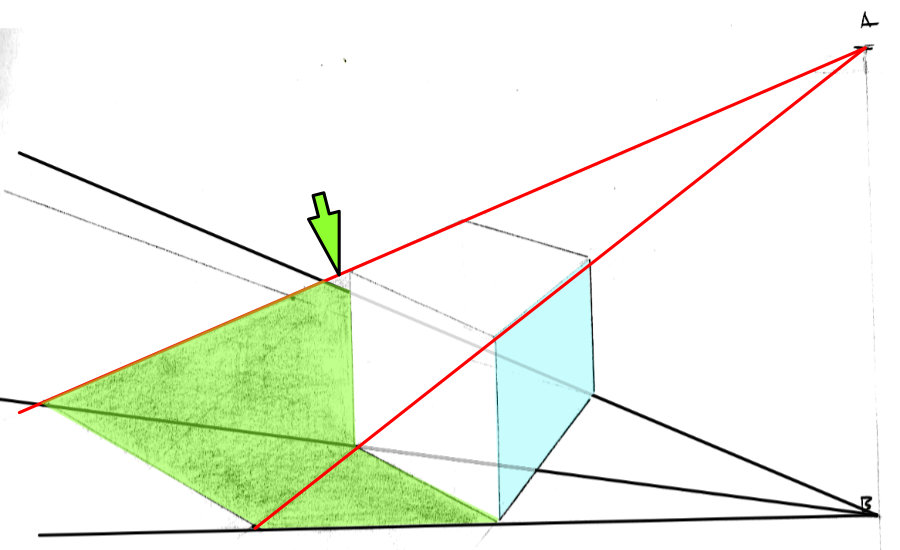
As A is directly above B, A can only see the light blue face and the top. So my red lines follow the corners I can see from up there.
Everywhere else, the light can see the ground. You've made life a little difficult for yourself because one face of the cube exactly follows the same red line . But you were almost entirely correct - just the tiny arrowed section was wrong.
OK.. let's move on to VERSION 2:
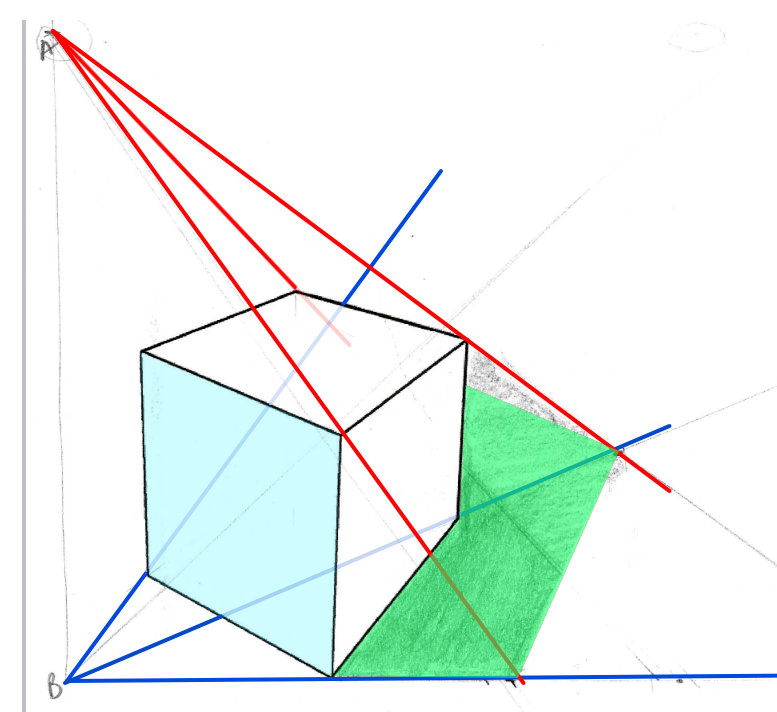
This might help you - assuming you need it!
Now what can you see from up there? Which are the furthest edges you can see that might block your vision of the ground? From up here (as the light) I can maybe see the top's left and right-hand corners and the far corner. The near corner doesn't count because I can see all the faces that spring from it. Now imagine where your line of sight for each corner meets the ground, allowing for any unevenness.
WEEK 7 EXERCISE 2

I'm not sure how to apply the angles for figuring lighting to a rounded object... I'm not happy with it but want to see what you say.
I'm sorry I haven't the time to work this out completely, but I have this one stored from a previous session, which is very similar:
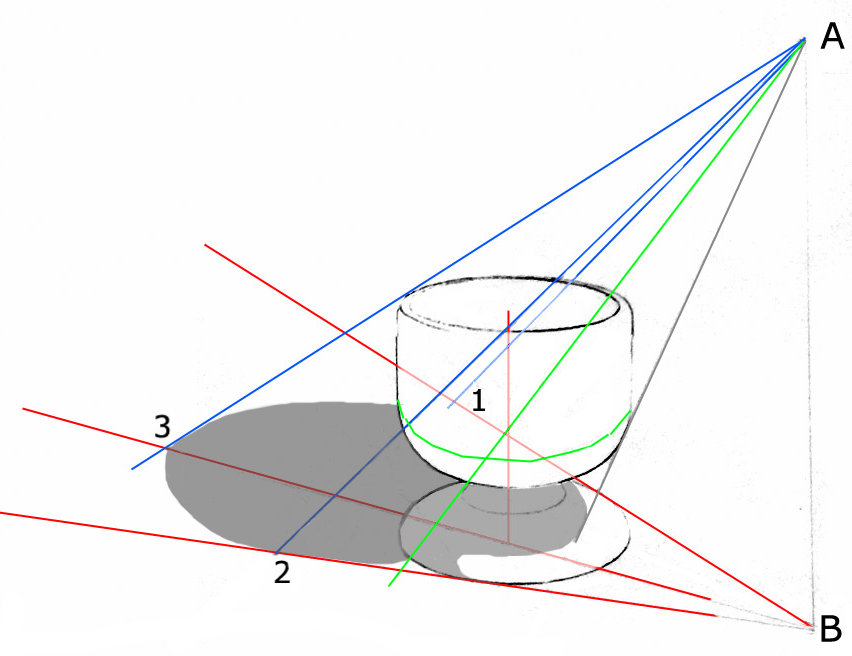
Red 1 and 2 give me the maximum width of the shadow. I'm assuming the cup and its base are the same width.
Blue 1 and 2 pass both sides at its widest point (as seen from A), which gives me the points at which the curve of the shadow meets the shadow of the sides.
Green is a line around the cup where the vertical side begins to curve underneath. The green ray passes through that curve (directly under the blue "widest point" above) so I now know where the shadow begins to curve back in.
The grey line marks where the shadow of the cup begins on its base.
The rest is eyeballed.
Enclosing it in a box won't work, because the corners of the box will all extend further out than the object itself. Construct the ground plane lines. Then, again, imagine you're the light. What can't you see from up there?
WEEK 7 EXERCISE 3
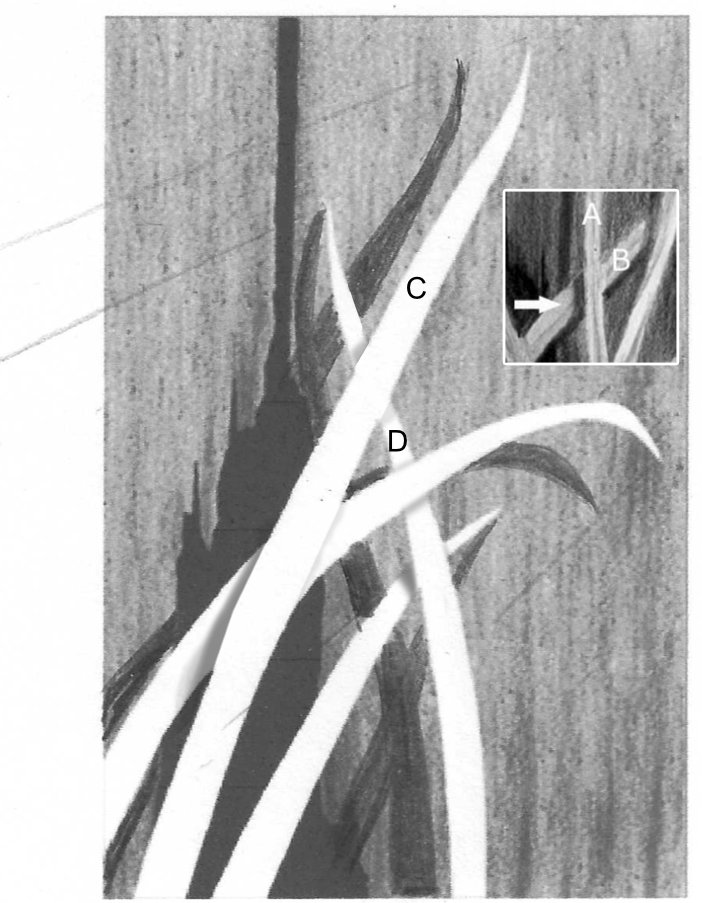
Otherwise this is very good. Those lines are exactly what you needed to do. This is splitting hairs a bit but, because this is sunlight, they should ALL be at the same angle. Due to its extreme distance as a light source, you can always assume sunlight rays travel in parallel straight lines. Also, your sun is very low in the sky, which is why my shadow cast by Leaf C on Leaf D is above the leaf rather than below.
But what really matters is that your cast shadows on the wall instantly describe the way each leaf bends, and their distance from the wall at any point. It's clearly obvious that some leaves bend back to touch the wall and others run parallel to it or lean back slightly.
As for the internal cast shadows... The further away the surface is from the leaf, the further the shadow has to travel. When the shadow of a leaf is projected both onto the wall AND another leaf, the shadow will split. The shadow of A on B (arrowed) has less distance to travel so it is nearer to A than the shadow of B cast on the wall.
In your drawing, the shadow of Leaf C on D has less distance to travel so it is nearer to C than the shadow cast on the wall. The shadows depend on which you think is in front of which, and what the angles of the leaves are. I've also introduced a little darker tone along the other edge of each leaf, just to define it. That's OK, but it has to be very subtle.
I hope this exercise proved to you how important and effective shadows are - even when the elements themselves contain no three-dimensional shaping.
Tutorials
by Mike Sibley




